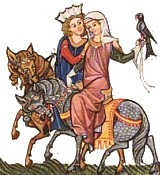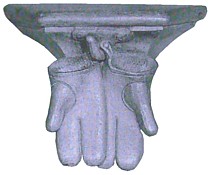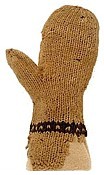|

Medieval
Gloves
HAWKING
GLOVES - GLOVES IN HOUSEHOLD ACCOUNTS - KNITTED GLOVES - GLOVES
FOR WORKERS
 Gloves
are one of the items mentioned by Andreas Capellanus in his 12th
century text, De Amore, when he speaks of what may and
may not be freely given to a lady love without being inappropriate- Gloves
are one of the items mentioned by Andreas Capellanus in his 12th
century text, De Amore, when he speaks of what may and
may not be freely given to a lady love without being inappropriate-
A lover may freely accept
from her beloved these things- a handkerchief, a hairband, a
circlet of gold or silver, a brooch for the breast, a mirror,
a belt, a purse, a lace for clothes, a comb, cuffs, gloves,
a ring, a little box of scent, a portrait, toiletries, little
vases, trays....
This indicates that gloves
were an item of clothing widely worn as a dress accessory, probably
in winter at the very least, by women of all classes and not solely
for utilitarian purposes.
Many time periods in history consider a well-bred woman improperly
dressed for society without hat and gloves, although there is
no way to tell if this also applied to medieval women.
Osbern Bokenham's Life of St Elizabeth talks of how devout
Elizabeth was when she was young saying:
...the Solemn Holy days
this girl observed with such devotion that would not permit
anyone to lace up her sleeves until after mass. On Sundays she
would not wear gloves until noon, no matter how cold it might
be...

Hawking
gloves
Hawking was a pastime which was very popular amongst upper class
ladies. Naturally, a specific glove would have been worn to protect
the lady's hand. The detail above right comes from the 1300-1320
German manuscript, the Manesse Codex shows a woman wearing
a hawking glove.

Gloves
in household accounts
Vary rarely do household accounts and wills include small items
like chemises, smocks, hose and gloves. Only in upper class inventories
where gloves are made from better materials or are made as special
gifts intended for special people, or those embroidered for the
clergy or for royals.
This is especially true of gloves for women.
One notable entry is in the the household accounts of the King's
Great Warderobe of 1360-1361, where the king made gifts to the
domicella of Brittany. Among them are listed eighteen pairs
of leather gloves.

 Gloves
for working Gloves
for working
Gloves were worn by outdoor workers, both male and female, for
practical purposes the same way that we wear gardening gloves
for heavy outdoor work ourselves.
The carved image of three-fingered gloves shown here date to 1498
and are from a misericord at the Cathedral of St John the Baptist,
in Maurienne, France.
They are typical of a unisex working glove and look to be made
of leather and lined with fur, or perhaps made of sheepskin with
the fleece to the inside. The split fingers allow for greater
ease of manipulation while working without the need to remove
the gloves altogether. Gloves like this can be seen in illuminations
of working class women who are performing gardening or farm work.

 Knitted
gloves Knitted
gloves
Only a few knitted items survive in tact from the late medieval
period, but among them is a knitted glove, now in the Museum of
London. There is a lot of early knitting with one needle known
as nahlbinding which is destinctly different fibre craft.
The lack of finds might be due to the nature of the item itself-
gloves are usually worn until no longer serviceable and then discarded.
The glove shown at right dates to the 15th century and comes from
a London deposit.
It is likely that the mitten style shown here was not worn by
the wealthy upper classes, but more likely knitted at home and
worn for warmth. The construction and method is simple, and is
still used today.

Copyright
© Rosalie Gilbert
All text & photographs within this site are the property of
Rosalie Gilbert unless stated.
Art & artifact images remain the property of the owner.
Images and text may not be copied and used without permission.
|